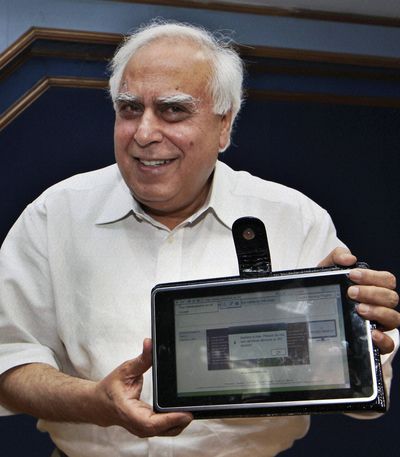Electronics on the cheap
India leading the way in development of low-cost products

MUMBAI, India – It looks like an iPad, only it’s 1/14th the cost: India has unveiled the prototype of a $35 basic touchscreen tablet, aimed at students, which it hopes to bring into production by 2011.
If the government can find a manufacturer, the Linux operating system-based computer would be the latest in a string of “world’s cheapest” innovations to hit the market out of India, which is home to the $2,127 compact Nano car, the $16 water purifier and the $2,000 open-heart surgery.
The tablet can be used for functions like word processing, web browsing and video-conferencing. It has a solar power option too – important for India’s energy-starved hinterlands – though that add-on costs extra.
“This is our answer to MIT’s $100 computer,” human resource development minister Kapil Sibal told the Economic Times when he unveiled the device Thursday.
In 2005, Nicholas Negroponte – co-founder of the Massachusetts Institute of Technology’s Media Lab – unveiled a prototype of a $100 laptop for children in the developing world. India rejected that as too expensive and embarked on a multiyear effort to develop a cheaper option of its own.
Negroponte’s laptop ended up costing about $200, but in May his nonprofit association, One Laptop Per Child, said it plans to launch a basic tablet computer for $99.
Sibal turned to students and professors at India’s elite technical universities to develop the $35 tablet after receiving a “lukewarm” response from private sector players. He hopes to get the cost down to $10 eventually.
Mamta Varma, a ministry spokeswoman, said falling hardware costs and intelligent design make the price tag plausible. The tablet doesn’t have a hard disk but uses a memory card, much like a mobile phone. The tablet design cuts hardware costs, and the use of open-source software also adds to savings, she said.
Varma said several global manufacturers, including at least one from Taiwan, have shown interest in making the low-cost device, but no manufacturing or distribution deals have been finalized.
She declined to name any of the companies.
India plans to subsidize the cost of the tablet for its students, bringing the purchase price down to around $20.
“Depending on the quality of material they are using, certainly it’s plausible,” said Sarah Rotman Epps, an analyst at Forrester Research. “The question is, is it good enough for students?”
Profitability is also a question for the $35 machine.
Epps said government subsidies or dual marketing – where higher-priced sales in the developed world are used to subsidize low-cost sales in markets like India – could convince a manufacturer to come on board.
If it works, Epps predicts the device could send a shiver of cost-consciousness through the industry.
“It puts pressure on all device manufacturers to keep costs down and innovate,” she said.
The project is part of an ambitious education technology initiative by the Indian government, which also aims to bring broadband connectivity to India’s 25,000 colleges and 504 universities and make study materials available online.